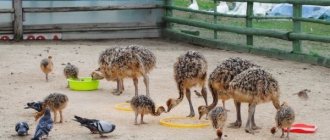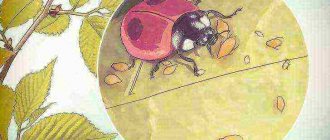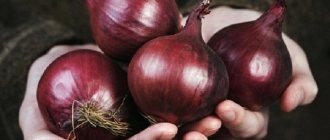Ostriches are considered exotic birds for our country, and they can only be found in zoos or on specialized farms. At the same time, breeding ostriches at home is a profitable business in terms of producing meat and eggs. In addition, it requires less expense than raising other domestic animals and poultry.
Although ostriches come from hot countries, they adapt well to the harsher conditions of Russia. So where to start? What conditions are required for breeding and keeping these birds? The following article will answer these and other questions.
- Peculiarities
- Peculiarities
What is the advantage of these birds
It would seem that the ostrich is an interesting bird, but why such difficulties when there are chickens. It’s a common thing, grow them, increase volumes and make a profit. This is how an ostrich breeder from Lithuania explains the profitability of the ostrich business.
Meat
According to this Lithuanian breeder, from one ostrich going to slaughter you can get:
- first-class meat - 20-25 kg at a price of 15 euros per kilogram;
- second class - 10-15 kg - 8-10 euros;
- raw salted leather worth 60-80 euros.
It turned out that one ostrich can bring an income of 500-600 euros. Its maintenance will cost from 150 to 200 euros. In total, the net profit will be 300-400 euros. So in Europe. According to him, profits in Russia will be higher, since the cost of expenses will be lower and the price of products will be higher.
Ostriches go to slaughter at ten to sixteen months of age. And he asks a logical question: how many chickens do you need to feed to get the same income as from one sold ostrich?
However, according to the Internet, ours turns out to be a little more modest.
- Ostrich fillet (1 kg) costs 650 rubles.
- An egg, depending on its weight, costs from 800 to 1000 rubles.
- Tanned leather for 1 sq. meter - 5000 rubles.
The price advantage is obvious. But the question of sales arises.
If you live near a city with a population of one million, it will be easier to organize sales of your products. There are still more rich people living there than in the provinces. The likelihood that they will want to at least try ostrich meat is much higher. But potential buyers give a good price only in the case of a large volume of products.
At first you will not be able to offer this. Some entrepreneurs cooperate to sell large volumes of goods at a higher price.
But ostrich breeding is interesting not only for the sale of meat.
Eggs
Ostrich eggs also have a high price. They are mainly sold for incubation and breeding. But they are also suitable for consumption. One ostrich egg can replace 30 chicken eggs. Its weight can be more than one and a half kilograms.
One ostrich egg is equal to thirty chicken eggs
The shell of eggs is yellowish-pink or green. It is used by artists for their works.
Ostriches lay eggs from March to October. During the season, an adult female can lay up to eighty eggs. But a young first-year girl will carry no more than twenty.
Feathers
Anyone who has read the book “The Three Musketeers” by Dumas remembers the magnificent hats of the musketeers with ostrich feathers. In those days, not only the brave musketeers had this accessory; ladies of high society also actively used it for their outfits.
Ostrich feathers are used to create costumes in various theatrical productions and variety shows.
Therefore, to accurately reproduce the spirit of that era in cinema and theater, a lush ostrich feather is in great demand. Feather boas, various accessories and souvenirs are made from it. They can remove dust from various objects and mechanisms. There will be no problems with the sale of this product.
Leather
Ostrich leather is valued just like crocodile leather. It is elastic and waterproof. Special cowboy boots and various leather goods are made from it. A purse is made from the skin of the tarsus of an ostrich's legs. One ostrich produces 1.5 square meters of leather.
Fat
Ostrich fat has healing properties, which is why it is especially valued. It relieves swelling, heals wounds, eliminates inflammation. It is even recommended for pregnant women. Before childbirth, it protects against stretch marks and eliminates itching. After childbirth, it helps speed up the healing of wounds.
For minor injuries and dislocations, ostrich fat can relieve pain, soothe itching, and reduce swelling.
It is actively used in cosmetics. It is the basis for the production of various moisturizing creams, nourishes nails, and protects against frostbite. This fat also promotes hair growth. It does not cause allergies and is odorless.
Claws and beak
Everything from this exotic bird is used. Even things that other birds usually throw away.
Crafts from ostrich claws
The claws are used to make powder. It is used to polish precious stones, even hard ones like diamonds.
Beak and claws are raw materials for the production of various crafts and souvenirs:
- amulets;
- necklaces;
- various cases;
- cases for flash drives.
Sales of products
Ostrich meat is still rarely found in hypermarkets, although the meat is extremely healthy, rich in protein and practically free of cholesterol. Restaurateurs, culinary shops and large stores are happy to enter into long-term contracts with peasant farms. They rarely work with individual entrepreneurs; LLCs and peasant farms are more reliable enterprises.
Ostrich lard and fat are also valued. The latter is in great demand in the pharmaceutical and cosmetology industries due to its range of oils, fats, disinfecting and restorative properties.
Ostrich leather has a wear life of 50 years, while calf leather lasts 5 years. Its moisture resistance is much higher, so shoes and bags made of ostrich are luxury items at a very affordable cost of leather.
An ostrich egg is an essential part of the diet of athletes. In addition, this product is highly valued for its mineral and vitamin composition by people who lead a healthy lifestyle, and especially by those who gain weight - bodybuilders, hockey players, and football players.
Feathers are used to produce accessories - suits, bags, hats, neck jewelry, key rings. Empty eggshells are painted as decoration and used to make bowls and vases. All this is excellent additional income.
You can read how to properly grow sturgeon at home and how to sell the resulting fish products here.
What breeds of ostriches are bred
The following breeds are distinguished.
- South American (rhea). The shortest and lightest breed of ostrich.
- Height is about 150 cm.
- Weight - 40 kg.
- Australian (emus). In terms of weight and height parameters, it occupies an average position in this breed of birds.
- Height - maximum 190 cm.
- Weight - 70 kg.
- African. They are the largest.
- Height - 2.7 meters.
- Weight - more than 150 kg.
By crossing a black African female with a Zimbabwean ostrich, a hybrid was developed that is most often used for breeding on private farms. They reproduce quickly and are easy to keep. They can easily tolerate both heat (+ 40 degrees) and cold (- 29 degrees). Only ostrich chicks up to six months need a temperature of at least sixteen degrees.
History of origin and habitat
More than two million years ago, ostriches were discovered on the African continent. However, according to some scientists, they came to Africa from Asia. Before the Ice Age, they already lived in Europe, China and India. This is evidenced by the found bones of 7-8 extinct representatives. Later they lived in the territory from the southern part of Ukraine to Central Asia.
The scientific name "struthio-camelus" translates to "camel sparrow". Like a camel, it can live in the desert and is able to travel long distances. It also has a large body and bulging eyes with long eyelashes.
In the mid-twentieth century, birds were completely exterminated in Arabia and Syria. Nowadays, the habitat of wild individuals is the treeless spaces of Africa. In southern Australia, only solitary representatives of the species can be found.
Previously, emus were classified as ostriches, but the classification was revised and today they are a separate species of bird.
Where to begin
Let's look at all the ways to enter this business.
- Buy hatching eggs. With this method you need
- be sure to get an incubator;
- pay 35 dollars for one egg.
As a result, the egg may not be fertilized, or the baby ostrich may not be viable. With this method, there is too high a chance that all your expenses and efforts will be in vain.
- Buy one-month-old ostrich chicks. One baby ostrich costs 10,000 rubles. This is the least expensive option for a beginning ostrich breeder.
- Buy an ostrich family. It is considered optimal when in a family of ostriches there are two females for one male. The cost per family is about $5,000. This start guarantees quick payback and income generation. But the costs in this case are significant. Requires a large starting capital.
Flaws:
- The need for large start-up capital.
- Difficulties with selling products.
- A lot of land is required for an ostrich farm.
Financial calculations
Investment in an ostrich farm
The initial investment consists of:
- purchase or construction of a poultry house, equipment - 1,200 rubles;
- purchase of an incubator - 250 thousand rubles;
- 75 adult birds – 4.5 million rubles.
Monthly expenses
- purchase of feed – 50 thousand rubles;
- salary, deductions - 30 thousand rubles.
Calculating profits and assessing project profitability
- sale of meat – $20/kg retail, $10/kg wholesale;
- eggs – 500 rubles per piece, for breeding – 1000 rubles per piece;
- sale of live poultry;
- tourism;
- feather - 70-200 $/kg, leather - 250 $/m2.
The average payback period for an ostrich farm is 3-4 years, provided there is a great desire and a large number of birds.
Ostrich ranches are one of the promising areas for the development of private business in agriculture. Despite the huge start-up investments, the business is profitable, and all costs will be repaid with interest.
How much land do you need for an ostrich farm?
According to the European minimum standards for keeping poultry, for one adult bird it is necessary:
- indoors (ostrich farm) - 10 sq. meters;
- in the enclosure - 100 sq. meters.
- There must be a distance of at least 200 meters between the rooms where breeders are kept for the production of hatching eggs and the room for raising ostrich chicks for up to three months. This is explained by the fact that ostrich chicks make sounds that resemble a call for help. Hearing them can cause breeders to stop laying eggs.
- Ostrich chicks are kept in groups of 40-50 birds for up to 14 months.
- Area standards for birds raised for slaughter, starting from 6 months of age
- indoors - 5 sq. meters,
- in the enclosure - 50 sq. meters.
For 100 heads of ostriches raised for meat, 1 hectare of land will be required.
Excursions to an ostrich farm can be an additional source of income
Depending on how many families of ostriches you plan to keep, the area of your farm will depend. Add to this area additional space for staff.
When equipping enclosures for ostriches, first of all, think about making it convenient for you to maintain them yourself.
Ostrich breeding options:
- Intensive. Ostriches are kept in a small area. Man supplies everything necessary for his existence. The least comfortable option for ostriches.
- Extensive. Conditions are created that are as close to natural as possible. Requires a large amount of land.
- Semi-intensive. According to this method, feeding is almost entirely carried out by humans, but more comfortable conditions are created for the ostrich. This poultry keeping system is usually used by beginning ostrich breeders.
Artificial incubation
In farm conditions, artificial breeding of chicks in incubators is preferable. The reasons are as follows:
- High cost of eggs . With natural incubation, losses are inevitable - some of the eggs will not be hatched, and these eggs are no longer suitable for food. With artificial incubation, hatchability is much higher.
- The faster you take an egg from a female ostrich, the faster she will lay a new one . Under natural conditions, having laid eggs, the female stops laying eggs. This is especially true for rheas, which begin to hatch from the first egg.
- The farmer has the opportunity to focus not on the ability of ostriches to hatch eggs, but on the farm’s ability to support young animals.
- During natural incubation, one bird can warm no more than 15 eggs with its body . The capabilities of the incubator are limited only by its design.
In addition, incubation may be required in cases where young females do not show parental instinct.
Standard incubators for chicken, goose or duck eggs are not suitable for hatching ostrich chicks. You should purchase or make a specialized incubator.
Artificial incubation occurs as follows:
- The laid eggs (all or those left outside the nest) are collected by the operator . This must be done extremely carefully due to the increased aggressiveness of the male. If necessary, two people should work, using hooks or sticks with loops to hold the bird.
- Selected eggs are stored at a temperature of 16-18 degrees for no more than 7 days . After this, the embryo dies, and the eggs are only suitable for food. When storing eggs, you need to turn them twice a day.
- Hatching eggs are washed with a soft brush in a solution of Virkon-S or a similar preparation, then dried and placed in an incubator.
- Incubation is carried out at a temperature of 36-36.4 degrees for 42-43 days . On day 41, it is recommended to move the eggs to a special hatcher. During the entire period of incubation, the correct development of the embryo is regularly monitored using an ovoscope.
Incubation mode:
| Day of process | Temperature, degrees | Air humidity, % | Turns the egg trays, once | Ovoscopy |
| 1-14 | 36,3-36,5 | 20-25 | 24 | On days 7 and 13 |
| 15-21 | 36,3-36,5 | 20-25 | 24 | On the 20th day |
| 22-31 | 36,3-36,5 | 20-25 | 3-4 | On the 27th day |
| 32-38 | 35,8-36,2 | 20-25 | – | On the 35th day |
| 39-40 | 35,8-36,2 | 40-45 | – | Not produced |
| 41-43 | 35,8-36,2 | 60-70 | – | Not produced |
Eggs in the incubator must be kept in a strictly vertical position.
Immediately after hatching, the chicks are transferred to a brooder - a cage with a tray and heating elements. There they should spend 2-3 hours drying. After this, they are weighed and the umbilical cord is disinfected. Weighing and disinfection are carried out over the next 2-3 days. The weight of a healthy hatchery ostrich chick ranges from 500 to 900 g.
Arrangement of premises at an ostrich farm
Although ostriches are birds, it is impossible to keep them like chickens or geese. They need the construction of pens and ostrich flocks with separate sections for each family. And also with a ceiling height in the room of at least 3.5 meters.
The height of the ostrich flock must be at least three and a half meters
An ostrich family consists of one male and two to four females. It is optimal to have two females. Then almost all the eggs they lay will be fertilized. At the beginning, there is a struggle between the females for the right to be the “favorite” friend of the male. Make sure they don't end up with bloodshed.
It happens that the stronger female begins to chase the weaker one around the enclosure, and she rushes about, not knowing where to hide. In this case, place a haystack or just a wooden shield in the enclosure. When the victim disappears from the aggressive female’s field of vision, she will calm down.
When arranging rooms for ostriches, take into account their timidity. Therefore, place ostrich flocks and enclosures away from various noisy stimuli. Also, one of the sides of the enclosure should be at least 40-60 meters long. Since, in case of fright, the ostrich runs exactly the same number of meters in order to calm down a little. Otherwise, out of fright, he will destroy everything and hurt himself.
Ostriches at the feeder
Although the ostrich is a hardy bird, it should not be brought to extreme conditions. It is better to insulate the ostrich fowl well using methods available to you. It is advisable that the temperature in it does not fall below 16 degrees Celsius in winter, and does not rise above 23 degrees in summer.
It should be dry and with good ventilation. Ammonia fumes from feces can lead to the death of livestock.
Farms for meat production are equipped with the following.
- A room for young animals up to three months old and a walking area for them. The bedding in it should be made of sand. The use of other materials is undesirable. Since the stomachs of ostriches are not yet strong, they, due to their curiosity, can swallow sawdust or straw. It should be warm (+ 28 degrees). Therefore, in winter it must be heated.
- Ostrich breeder for young animals from three months to slaughter. Here you can already use straw bedding. You can build an ostrich nest from a metal frame covered with polycarbonate or sandwich panels. In this case, due to tightness and condensation formation, special attention must be paid to ventilation. One ostrich should have 5 sq. meters indoors, and 50 sq. meters in the enclosure.
- A room for ostrich families. It is equipped in the same way as in the previous case. only each family should have its own section. For one adult ostrich, 10 square meters should be allocated in the room. meters. The enclosure is 100 sq. meters.
- Aviaries. To fence them, you can use three-meter wooden posts with a diameter of 20 cm, dug in every three meters. Four poles are nailed between them, at a distance of half a meter from each other. Sometimes they stretch the net. It is better to place them on sandy soil, as in Africa.
- A room for breeders (multipliers) - females carrying hatching eggs.
- Hatcheries. Incubators are installed there to hatch young animals.
Specific Features
Ostriches have a tiny brain, weighing 30-40 grams. They absorb information very poorly and process it slowly. For this reason, any, even the slightest blow to their head can be fatal.
When building a fence for a menagerie, one more physiological property of birds must be taken into account. They like to stick their head into various openings, such as a hole between a fence. Because their memory is very short, they instantly forget how they got their head in and how to get it out. In panic, they begin to twitch and frantically try to free themselves. Often the skull is displaced from the cervical vertebrae, which leads to the death of the pet.
Ostrich equipment
All ostrich coops must have feeders and drinkers installed. Standards for arranging feeders.
- There should be at least half a meter of feeder per baby ostrich.
- For an adult ostrich - one and a half meters.
- They are filled to two-thirds of the volume.
- Senniks (grass feeders) are fixed at a height of just over fifty centimeters.
The drinking bowls must be stable so that the ostriches do not get wet. This is very dangerous for them. They may die from this. Choose white drinking bowls. Young animals find them faster. Automatic drinkers with a water volume of 30 liters are convenient. Renew water in drinking bowls daily.
Caring for chicks
Separation of young animals from adult stock is not necessary, but it is advisable to avoid transmission of the disease from adult ostriches to chicks. Premises and pens for ostrich chicks should be cleaned of excrement daily, and the bedding should be replaced with fresh litter.
Ostriches are susceptible to all ornithosis found in Russia, so consultation with veterinarians and, if necessary, vaccinations are important.
The first feeding of the young is carried out 4-6 days after hatching. In the future, feeding is carried out with compound feeds:
| Age, months | Type of feed | Quantity per 1 head, g | Additional measures |
| 0-2 | Pre-launch | 300 | Half an hour after feeding, the feeders are washed and disinfected |
| 2-4,5 | Starting | 1100 | Gravel finer than 3 mm is added |
| 4,5 — 7 | Fattening | 1650 | Start adding greens and vegetables to the food |
| 7 – 10,5 | Finishing | 2500 | |
| 10,5 – 12 | Finishing or finishing | 3000 |
Starting from 12 months, young animals are ready for slaughter. Only breeding animals are kept longer.
Feeding
When feeding ostriches, it is easier and better to use ready-made feed. All nutritional elements in such feeds are balanced. But in this case, maintenance costs will increase by almost 40%.
To calculate feeding costs, it is necessary to take into account that
- an ostrich eats 400-500 kg of food up to 12-14 months a year,
- older ostrich - 700-800 kg of feed.
You are unlikely to find separate feed for ostriches. Therefore, use chicken feed for the appropriate age group.
Ostriches need grass
They also need grass (they like alfalfa) and shell rock with vitamins. The young are fed four times a day. Then he is transferred to the diet of an adult bird - twice a day (morning and evening). Do not leave the daily dose of food for the next day.
When females lay eggs they require increased nutrition. Therefore, they are advised to be fed separately from males.
There is no need to feed ostrich chicks for a week after birth. Their stomach is not yet able to digest food coming from outside. What was already in the egg is enough for them. After this time, the ostriches are fed as follows:
- up to a month - mixed feed, in which the protein content is 24%. You can give cottage cheese and boiled eggs, alfalfa (it has a lot of protein);
- from a month to three - the protein content in feed decreases to 19%, and fiber to no more than 12%.
- For the proper functioning of the stomach, grown young birds, just like adult birds, need gravel pebbles.
Ostrich chicks on a walk
Ostrich chicks, like chickens, whoever takes care of them, they listen to him, and they follow him. To avoid infection of young animals, they must be kept separate from adults. Chicks should add five grams of B vitamins to their drinking water.
Main benefits of breeding
The key point in raising ostriches is the possibility of obtaining meat; just one pair of these giant birds makes it possible to obtain more than 1800 kg of a healthy dietary product. The productivity of females is amazing - each of them is capable of giving birth to at least 40 cubs, which are ready for slaughter at the age of 10 months. At this time, the weight of ostriches reaches about 100 kg.
The life expectancy of the bird is 26-35 years, while ostriches maintain excellent productivity for most of their lives.
Ostrich eggs
Product Features:
- Weight up to 1.5 kg.
- Low cholesterol content.
- It will take an hour and 15 minutes to cook an egg.
Ostrich leather
Highly valued throughout the world due to its wear resistance, strength and elasticity. The skin from the back or sternum of a bird is considered the best; it has an original pattern.
Note! Leather from ostrich paws is used in the shoe industry.
Ostrich fat
From each adult bird you can get 5-6 kg of this product, in some cases the fat mass can exceed 15 kg, especially if the ostriches were fed balanced feed.
It is used in pharmaceuticals to create ointments for joints and muscles, and also in cosmetology as a moisturizer.
Poultry health
Due to the uniqueness and high cost of the bird, concern for its health comes to the fore. Ostriches are at risk for respiratory and gastrointestinal diseases. That’s why it’s so important for them to have no drafts in the ostrich nest and to comply with sanitary and hygienic standards.
- Regularly maintaining cleanliness in the poultry house and changing litter. Clean drinking bowls and feeders daily.
- Checking ostrich feces for changes in color, consistency, and the presence of parasites. This way you can detect intestinal infections in time.
- Vaccinate the bird in a timely manner.
- Set up a quarantine pen. It must contain poultry purchased from other farms. And also our own with the first signs of the disease.










